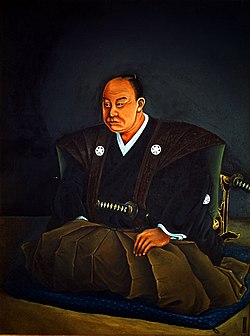Daimyo

Daimyō ( Japanese 大名 ), often referred to as prince in German , were local rulers in feudal Japan .
The word, meaning "big name" in this spelling, was originally a short form of Dai myōshu ( 大名 主 ) and referred to their large estates. From the 12th century onwards, the word gradually became a term for a position within the samurai .
The daimyō were mainly members of the sword nobility ( buke ) and were formally subject to the shogunate . For their part, they had samurai as vassals , whom they had to pay from the income of their fief ( han ). Since the central power could not enforce its power over long stretches of the Muromachi period, many daimyo were able to rule their fiefs de facto completely independently.
Muromachi period
During the Muromachi period (1336-1573) Shugo daimyō appeared as military governors ( Shugo ) of the Ashikaga shogunate . The Ashikaga shogunate managed to strengthen the central power again for about 150 years through repressive regulations such as conscription so that separatism could be suppressed by the local rulers for a while. However, over time they gained more and more influence in their fiefs, so that by tradition the role of Shugo soon became hereditary and passed on to the houses of the daimyo.
Sengoku time
In the Sengoku period (1477–1573), the central government was further weakened, as a result of which the daimyō gained strong influence and assumed the roles of sovereign princes, many of whom sought the unification of the entire country under the banner of their own clan.
Edo period
At the beginning of the Edo period (1603–1868) the shogun Tokugawa Ieyasu, who had come to power, regulated the system of his now subservient daimyo so that the minimum income was 10,000 koku rice. By imposing numerous duties, the Tokugawa shogunate was able to gain greater control over the daimyo. So they had to spend half of their time in Edo as part of the sankin kōtai . During their absence, they had to leave their wife hostage in Edo.
The main classification of daimyo in the Edo period was:
- Shimpan daimyo (親 藩 大名 ): Relatives of the Tokugawa
- Fudai daimyō (譜 代 大名 ): those whosided with Tokugawa Ieyasuat the Battle of Sekigahara .
- Tozama daimyo (外 様 大名 ): those who were on the losing side at the Battle of Sekigahara and who weresparedthe seppuku invitation after the battle. These Tozama daimyo could not hold any office in the shogunate. It was they who overthrew the shogunate in 1868.
Further classification of the daimyo in the Edo period:
- Kakaku ( 家 格 ): family class
- Kan'i ( 官位 ): rank of office at the imperial court
- Kokudaka ( 石 高 ): travel income
- Yakushoku ( 役 職 ): Place in the Edo shogunate
The shogunate arranged the fiefs so that the capital Edo was largely surrounded by Fudai daimyo. The Tozama daimyo, however, were given fiefs in the periphery because of their earlier opposition to the Tokugawa.
The daimyo were controlled by strict laws of the Edo shogunate. In the Edo period there were about 260 daimyo and thus 260 Han .
After the end of the shogunate, in the early Meiji period in 1869 , the government asked the daimyo to return their right to govern land and people to the court. All daimyō followed this recommendation and then became Chihanji (governor of Hans). In 1871 the government decided to abolish the Han and instead set up prefectures . The former daimyo raised the government to the new nobility Kazoku . Their status was based on the size of their previous fiefdom.
literature
- E. Papinot: Historical and Geographical Dictionary of Japan. Tokyo around 1909. (Reprint: Tuttle-Verlag, Rutland 1972, ISBN 0-8048-0996-8 )